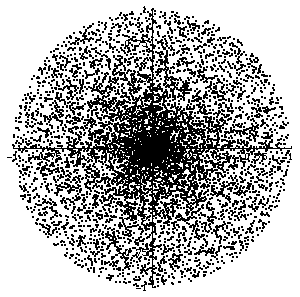 |
| DiskIFS0[10000] |
using two maps applied to the polar form (r, a) of complex numbers:
Fi(r, a) = (a/(2Pi), (r + i)Pi)
where i = 0 or 1 and 0 =< r =< 1 and 0 =< a =< 2Pi.
The Matematica code for these figures is included here.
|
IFS for a disk
using two maps applied to the polar form (r, a) of complex numbers: Fi(r, a) = (a/(2Pi), (r + i)Pi) where i = 0 or 1 and 0 =< r =< 1 and 0 =< a =< 2Pi. |
|
IFS for a disk with constant density
Define an IFS in the (r,s)-plane, consisting of two linear maps, who attractor is the triangle 0 =< r =< 1 and 0 =< s =< r. Then map the point (r,s) in the triangle to the point in the disk with polar form (r, a) where a = 2(s/r)Pi. |
|
IFS for a disk with constant density
showing the images of the two maps The maps are the same as in the previous example. The colors represent the images of the two maps. |
|
IFS for a disk with constant density
showing the images after two iterates The maps are the same as in the previous two examples. The colors represent the four possible images after two iterates of the two maps. |
|
Yin Yang IFS
A modification of the maps of the previous examples, showing the images of the two maps. The point (r,s) in the triangle gets mapped to the point in the disk with polar form (r, a) where a = 2(s/r)Pi + ArcCos(r). |
|
Yin Yang IFS
The maps are the same as in the previous example. The colors represent the four possible images after two iterates of the two maps. |